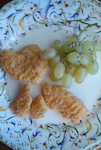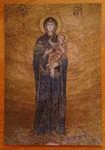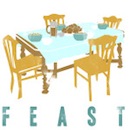Is there an aesthetic to this moral courage of realizing and learning? To me, it is the aesthetic of the windowsill, the threshold, the horizon line, the human face of another. It is framing one’s own perception to experience the expanse beyond it. The expanse, indeed, of the far fields.
The Pecan Orchard
The Orchard stands at the end of the road. Waiting. Solid, robust, kindly, full of route and routine, of dank pockets where rain has padded the soil, of the sound of small, dry leaves shaken by the wind. Oh, all the stories I played there: it was a kingdom of the imagined, an arena of the kind of grace that allows for further creation—however misplaced, silly, phantastical, fleeting, and even unreal.
Hearth and Threshold: Thoughts on a Theology of Home
So what would it look like for us to hold in tension both this graced capacity for making a secure dwelling as well as the possibility of leaving this dwelling? For me, part of this tension can be answered by looking at the architecture of a house.
Holy Island in Loch Derg
This very witness of love intertwines and melds with the aesthetical gift of Inis Cealtra: indeed, the beauty of these ruins forms their ecclesiastical lessons. The stones attest to the labor and handiwork of disciples long ago; arches and elegant stonework attest to the creativity of worship; moss, ivy, and grass attest to the wild edge of praise. These ruins teach us through their longevity, beauty, wildness, openness, emptiness, quietness. They teach us something about the heart of the Church—it is long-lasting, shared, and beautiful.
 The church was a place of incredible, deliberate, beauty. It had been some time since I’d been in a place of worship so utterly beautiful. As I walked down the main aisle and then the smaller aisles at the south and north portals, my son walked beside me. He’d never been in a church like this. It was his first time to behold, and in his little mind configure, how a church can look like this. Here is a human-made artifact of craftsmanship that, somehow, actually embodies the joy—the nearly incomprehensible reality—of Emmanuel, God with us.
The church was a place of incredible, deliberate, beauty. It had been some time since I’d been in a place of worship so utterly beautiful. As I walked down the main aisle and then the smaller aisles at the south and north portals, my son walked beside me. He’d never been in a church like this. It was his first time to behold, and in his little mind configure, how a church can look like this. Here is a human-made artifact of craftsmanship that, somehow, actually embodies the joy—the nearly incomprehensible reality—of Emmanuel, God with us.
 It’s not only that God shines out from orange slices and bookshelves. It’s that with grace, these things make love and goodness. These things—caring for these things, building and cleaning and keeping these things—make a place for the heart to rest and be cared for.
It’s not only that God shines out from orange slices and bookshelves. It’s that with grace, these things make love and goodness. These things—caring for these things, building and cleaning and keeping these things—make a place for the heart to rest and be cared for.
 I find it hard to sit with people.
I find it hard to sit with people.
I wish I meant that I find it hard to sit with people in a cramped room with a broken A/C or in a bad jury trial or even in a hospital waiting room. To my mind this is more understandable. But I mean I find it hard to sit with people in general. Like at a diner for more than half an hour. Or at a party. Or at the dinner table. Or at a park. Or on a walk. My social self, though, operates pretty adroitly, and I can spend hours at a diner or a party or a dinner table and have a pretty good time — it’s just that after awhile, something under my skin starts to crawl.
 It was in rereading the poems, though, that the poetry got left behind. I started reading these poems as prayers. And not prayers of the animals, but prayers for myself. These are prayers I would never know how to say, for the creature-like movements inside of me are intrinsically inarticulate. These poems are prayers for the animals inside of us — the heavy, slow, frightful, instinctive — those parts of us that fly and plod and bury down.
It was in rereading the poems, though, that the poetry got left behind. I started reading these poems as prayers. And not prayers of the animals, but prayers for myself. These are prayers I would never know how to say, for the creature-like movements inside of me are intrinsically inarticulate. These poems are prayers for the animals inside of us — the heavy, slow, frightful, instinctive — those parts of us that fly and plod and bury down.
 Twelve years ago in the little gift shop of St. Mary’s church in Oxford, I found a tray of laminated prayer cards. Assuming “An Ancient Country Prayer” would be about sun and harvest, I was surprised and delighted to read the first line:
Twelve years ago in the little gift shop of St. Mary’s church in Oxford, I found a tray of laminated prayer cards. Assuming “An Ancient Country Prayer” would be about sun and harvest, I was surprised and delighted to read the first line:
Give me good digestion, Lord, and also something to digest . . .
I pounced on it happily — here was a prayer I could relate to. I would not know then, as I drew out my coins, that this prayer card would go with me for the next years to other countries, into married life, into motherhood.
 For the force of hunger is a movement toward life, a movement of life. These pangs of hunger are evidence of hope, a sign to keep looking for things not yet seen, not yet at hand. If I were full, would I need to keep traveling? The pilgrimage might come to an early end.
For the force of hunger is a movement toward life, a movement of life. These pangs of hunger are evidence of hope, a sign to keep looking for things not yet seen, not yet at hand. If I were full, would I need to keep traveling? The pilgrimage might come to an early end.

















